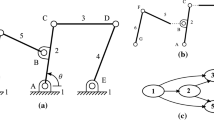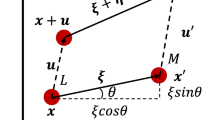Abstract
A solution method suitable for the multi-threaded simulation ofmechanical systems represented in Cartesian coordinates isproposed and analyzed. In a state-space framework for thesolution of the Differential Algebraic Equations (DAE) ofMultibody Dynamics, the position/velocity stabilization and theacceleration computation are based on iterative solvers applied toequivalent reduced problems. The most in-depth computationalaspect analyzed is the preconditioning, i.e., the direct solutionof the reduced systems. Provided a topology index reduction is first applied to the model, the effort for the direct solution of the reduced systems is shown to be of order O(N J ), where N J is the number of joints in the model. The recurring theme of thepaper is the central role that the topology of the mechanicalsystem plays in the overall performance of the numericalsimulation. Based on the topology of the model, parallelcomputational threads can be established to start in the equationformulation and continue through the iterative numericalalgorithms employed for the numerical solution. Task schedulingthese parallel threads is expected to redeem real-time performancefor certain classes of complex applications.
Similar content being viewed by others
References
Anderson, K.S. and Duan, S., ‘A hybrid parallelizable low order algorithm for dynamics of multi-rigid-body systems: Part I, Chain systems’, Journal of Mathematical and Computer Modelling 30, 1999, 193–215.
Ascher, U.M., Chin, H. and Reich, S., ‘Stabilization of DAEs and invariant manifolds’, Numerische Mathematik 67(2), 1994, 131–149.
Ascher, U.M. and Petzold, L., Computer Methods for Ordinary Differential Equations and Differential-Algebraic Equations, SIAM, Philadelphia, PA, 1998.
Baraff, D., ‘Linear-time dynamics using Lagrange multipliers’, in Proceedings of the 23rd Annual Conference on Computer Graphics and Interactive Techniques, ACM Press, 1996, 137–146.
Baumgarte, J., ‘Stabilization of constraints and integrals of motion in dynamical systems’, Computer Methods in Applied Mechanics and Engineering 1, 1972, 1–16.
Bertzekas, D., Nonlinear Programming, Athena Scientific, Belmont, MA, 1995.
Chandra, R., Menon, R., Dagum, L., Kohr, D., Maydan, D. and McDonald, J., Parallel Programming in OpenMP, Morgan Kaufmann Publishers, San Mateo, CA, 2000.
Featherstone, R., ‘The calculation of robot dynamics using articulated-body inertias’, International Journal of Robotics Research 2(1), 1983, 13–30.
Featherstone, R., Robot Dynamics Algorithms, Kluwer Academic Publishers, Dordrecht, 1987.
Fuhrer, C. and Leimkuhler, B., ‘Numerical solution of differential-algebraic equations for constrained mechanical motion’, Numerische Mathematik 59, 1991, 55–69.
Gear, W.C., Gupta, G. and Leimkuhler, B., ‘Automatic integration of the Euler—Lagrange equations with constraints’, Journal of Computational and Applied Mathematics 12, 1985, 77–90.
Golub, G.H. and C.F.Van Loan, C.F., Matrix Computations, second edition, The Johns Hopkins University Press, Baltimore, MD, 1989.
Haug, E.J., Computer Aided Kinematics and Dynamics of Mechanical Systems, Allyn and Bacon, Boston, MA, 1989.
Haug, E.J., Negrut, D., Serban, R. and Solis, D., ‘Numerical methods for high speed vehicle dynamic simulation’, Mechanics of Structures and Machines 27, 1999, 507–533.
Karypis, G. and Kumar, V., ‘A high performance sparse Cholesky factorization algorithm for scalable parallel computers’, Technical Report 94-41, Department of Computer Science, University of Minnesota, 1994.
Lubich, C., Nowak, U., Pöhle, U. and Engstler, C., ‘MEXX —Numerical software for the integration of constrained mechanical multibody systems’, Techical Report SC 92–12, ZIB Berlin, Germany, 1992.
Lubich, C., Nowak, U., Pöhle, U. and Engstler, C., ‘An overview ofMEXX: Numerical software for integration of multibody systems’, in Advanced Multibody System Dynamics, W. Schiehlen (ed.), Kluwer Academic Publishers, Dordrecht, 1993, 421–426.
Markowitz, H., ‘The elimination form of the inverse and its application to linear programming’, Management Science 3, 1957, 255–269.
Negrut, D., ‘On the issue of iterative linear algorithms for the multi-threaded simulation of mechanical systems represented in Cartesian coordinates’, in Virtual Nonlinear Multibody Systems, NATO Advanced Study Institute Series, Vol. 1, W. Schiehlen and M. Valašek (eds.), 2002, 144–149.
Pacheco, P., Parallel Programming with MPI, Morgan Kaufmann Publishers, San Mateo, CA, 1996.
Potra, F. and Rheinboldt, W.C., ‘On the numerical solution of the Euler-Lagrange equations’, Mechanics of Structures and Machines 19, 1991, 1–18.
Rothberg, E. and Hendrickson, B., ‘Sparse matrix ordering methods for interior point linear orogramming’, Information and Computation 10(1), 1998, 107–113.
Schiehlen, W. (ed.), Advanced Multibody System Dynamics — Simulation and Software Tools, Kluwer Academic Publishers, Dordrecht, 1993.
Shabana, A.A., Dynamics of Multibody Systems, Cambridge University Press, Cambridge, 1998.
Wehage, R. and Haug, E., ‘Generalized coordinate partitioning for dimension reduction in analysis of constrained dynamic systems’, ASME Journal of Mechanical Design 104(1), 1982, 247–255.
Author information
Authors and Affiliations
Rights and permissions
About this article
Cite this article
Negrut, D. Linear Algebra Considerations for the Multi-Threaded Simulation of Mechanical Systems. Multibody System Dynamics 10, 61–80 (2003). https://doi.org/10.1023/A:1024515521451
Issue Date:
DOI: https://doi.org/10.1023/A:1024515521451




